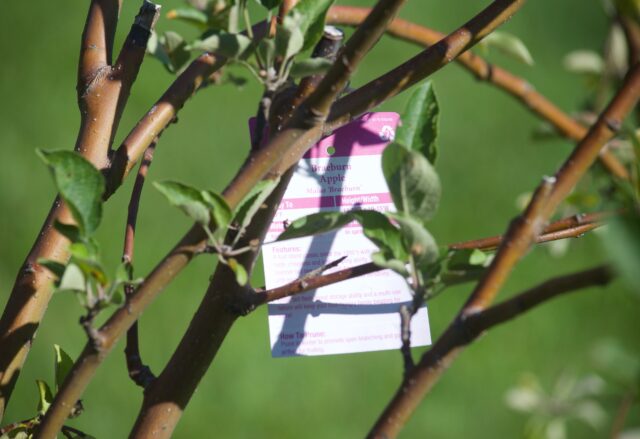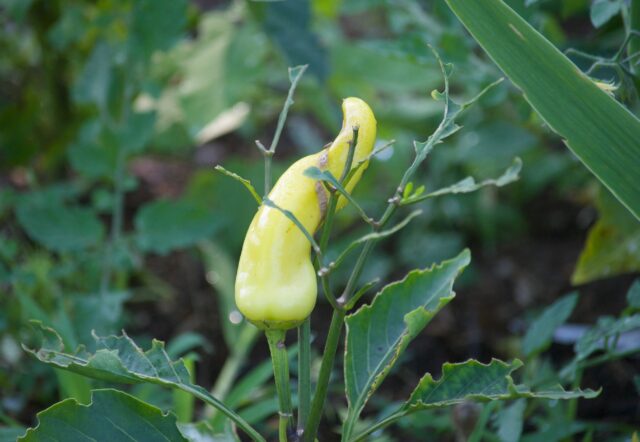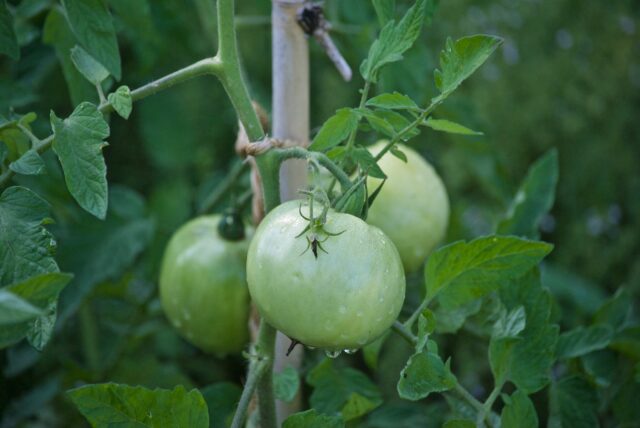What’s happening over in Zion Hill Cemetery today is not unprecedented.
In British Columbia, a cemetery grows vegetables to give to the community; they also keep bees and harvest their honey. There’s (at least) one graveyard veggie garden in Pennsylvania. A Virginia cemetery sells “Died And Gone To Heaven” honey produced by bees kept on site. During World War II, unused burial plots were used as Victory Gardens.

At Hartford’s Zion Hill Cemetery, the food grown is for anyone to take. In only a few short years, the graveyard went from being trees, grass, and a few flowers planted around tombstones, to containing apples, blueberries, tomatoes, peppers, other vegetables, and herbs, along with flowers for the bees. The Friends of Zion Hill Cemetery consulted with the cemetery grounds crew to ensure that they were not planting above any used plots. The vegetable garden is directly next to the Allen Street entrance, herbs are by the fence on Zion Street, and the newer flower gardens are at the Ward Street entrance and by the Caretaker’s Cottage.

Despite not being directly over any plots, some reading this are likely squeamish about it. In the cemetery, there are lots of groundhogs, squirrels, and birds, and they’re all eating food that has grown from that ground. I don’t know what that says about food being safe for human consumption, but it’s not a total dead zone.
We should be concerned about standard modern mortuary practices. Besides pumping the deceased — and later, the ground — full of harmful chemicals, the norm is to essentially landfill materials that could be put to more productive use. Caskets are not required for burial, but you would not know that from current norms. That’s the creepy part of what is under the cemetery grass. Sometimes, the cemetery groundhogs burrow into plots and drag up parts of caskets.
There are regulations about burial depth and proximity to reservoirs. Bodies in Connecticut do not need to be buried six feet down. That might not actually be comforting.
As for food production in general, it may be worth reminding people that soil is not some brown mystery substance that merely exists to stabilize plants. Soil is filled with microbes. “There are more microbes in a teaspoon of soil than there are people on the earth.” That’s not to say that all soil is safe for growing food in– testing for contamination is important. Humans have wrecked so much, but we also have ways of correcting our errors. Brownfield remediation is a thing. But for everyone icked out by the idea of food grown near dead bodies, it’s worth remembering a few things: (1) how many times is industrial food recalled for contamination? Just this week Trader Joe’s cookies were found to have rocks in them. Rocks! (2) have you seen factory farms? How is that any better?

Even if no people decide to take a chance on the food grown in a cemetery, it still serves several purposes. The resident animals will eat from the gardens. Plants with more complex root structure help prevent erosion. Apple trees provide habitat for birds. There’s color and texture making for a more beautiful landscape than would be in a space that is mostly boring grass. And also, for those wondering how to deter things like vandalism, a vegetable garden requires frequent attention in a way that merely mowing a lawn does not, and this means more positive use of the space.
Climate Possibilities is a new series about climate mitigation, along with resilience, resistance, and restoration. It’s about human habitat preservation. It’s about loving nature and planet Earth, and demanding the kind of change that gives future generations the opportunity for vibrant lives. Doomers will be eaten alive, figuratively. All photographs are taken in Hartford, Connecticut unless stated otherwise.
Abundance
What’s happening over in Zion Hill Cemetery today is not unprecedented.
In British Columbia, a cemetery grows vegetables to give to the community; they also keep bees and harvest their honey. There’s (at least) one graveyard veggie garden in Pennsylvania. A Virginia cemetery sells “Died And Gone To Heaven” honey produced by bees kept on site. During World War II, unused burial plots were used as Victory Gardens.
At Hartford’s Zion Hill Cemetery, the food grown is for anyone to take. In only a few short years, the graveyard went from being trees, grass, and a few flowers planted around tombstones, to containing apples, blueberries, tomatoes, peppers, other vegetables, and herbs, along with flowers for the bees. The Friends of Zion Hill Cemetery consulted with the cemetery grounds crew to ensure that they were not planting above any used plots. The vegetable garden is directly next to the Allen Street entrance, herbs are by the fence on Zion Street, and the newer flower gardens are at the Ward Street entrance and by the Caretaker’s Cottage.
Despite not being directly over any plots, some reading this are likely squeamish about it. In the cemetery, there are lots of groundhogs, squirrels, and birds, and they’re all eating food that has grown from that ground. I don’t know what that says about food being safe for human consumption, but it’s not a total dead zone.
We should be concerned about standard modern mortuary practices. Besides pumping the deceased — and later, the ground — full of harmful chemicals, the norm is to essentially landfill materials that could be put to more productive use. Caskets are not required for burial, but you would not know that from current norms. That’s the creepy part of what is under the cemetery grass. Sometimes, the cemetery groundhogs burrow into plots and drag up parts of caskets.
There are regulations about burial depth and proximity to reservoirs. Bodies in Connecticut do not need to be buried six feet down. That might not actually be comforting.
As for food production in general, it may be worth reminding people that soil is not some brown mystery substance that merely exists to stabilize plants. Soil is filled with microbes. “There are more microbes in a teaspoon of soil than there are people on the earth.” That’s not to say that all soil is safe for growing food in– testing for contamination is important. Humans have wrecked so much, but we also have ways of correcting our errors. Brownfield remediation is a thing. But for everyone icked out by the idea of food grown near dead bodies, it’s worth remembering a few things: (1) how many times is industrial food recalled for contamination? Just this week Trader Joe’s cookies were found to have rocks in them. Rocks! (2) have you seen factory farms? How is that any better?
Even if no people decide to take a chance on the food grown in a cemetery, it still serves several purposes. The resident animals will eat from the gardens. Plants with more complex root structure help prevent erosion. Apple trees provide habitat for birds. There’s color and texture making for a more beautiful landscape than would be in a space that is mostly boring grass. And also, for those wondering how to deter things like vandalism, a vegetable garden requires frequent attention in a way that merely mowing a lawn does not, and this means more positive use of the space.
Climate Possibilities is a new series about climate mitigation, along with resilience, resistance, and restoration. It’s about human habitat preservation. It’s about loving nature and planet Earth, and demanding the kind of change that gives future generations the opportunity for vibrant lives. Doomers will be eaten alive, figuratively. All photographs are taken in Hartford, Connecticut unless stated otherwise.
Related Posts
Newfield Avenue Detour
Fatal Accidental Drug Overdoses in Hartford
April’s Airing of Grievances Approaches